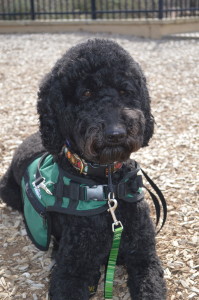About Hope
 Hope was born on September 19, 2010. She came to us about 4 months after she turned 2. At 8 weeks of age, she started her training to be a service dog. This included basic obedience training and socialization so that she would be comfortable out in the community. Of course, I cannot speak to the details of her training because I am not a trainer and, frankly, I don’t need all the details. My point in bringing this up is to say that Hope has spent her entire life training for the job she has now. People often ask me if their pets can be trained to be a service dog. My answer is, “Probably not. The training has to start from early puppyhood.”
Hope was born on September 19, 2010. She came to us about 4 months after she turned 2. At 8 weeks of age, she started her training to be a service dog. This included basic obedience training and socialization so that she would be comfortable out in the community. Of course, I cannot speak to the details of her training because I am not a trainer and, frankly, I don’t need all the details. My point in bringing this up is to say that Hope has spent her entire life training for the job she has now. People often ask me if their pets can be trained to be a service dog. My answer is, “Probably not. The training has to start from early puppyhood.”
Also, let me clarify terminology: Hope is a service dog. That is different than a therapy dog. A service dog is meant to guide and assist a person with a disability to navigate the environment at home and in the community. A service dog is a highly trained animal that is allowed by federal and state laws in any public place. They are assigned to one individual for their role as a lifetime assistant to the person with the disability. A therapy dog is meant to assist with emotional or psychological stress associated with disability or trauma. These animals help patients work towards specific physical, social, cognitive or emotional goals. A therapy dog is not usually assigned to just one person. They generally work in facilities like hospitals, nursing homes, schools or psychiatric offices to help many patients. If you have a well-trained pet with a very calm demeanor, this kind of full-grown dog can be trained to be a therapy dog.
During her training, Hope learned the difference between the times when she has her service pack on and when it is off. When her service pack is on, she is on the job. She knows this and will always exhibit exceptional behavior as well as a rock-solid calm demeanor. She is not distracted by other animals or food and she remains focused on her boy at all times. She knows her job and she takes it seriously. But, when her pack comes off, she is just a well-trained house pet. She runs around the yard, barks at squirrels, plays with the kids or other dogs and loves chewing on bones while she relaxes on her dog bed. It is important for us, as a family, to help find the balance between giving her “time off from work” and still remaining calm to maintain her calm demeanor. That is a challenge in my household, but we are working on it.
When she is wearing her service pack, no one is allowed to pet her besides Gray or the adult who is her handler. This is a hard one for people to understand. I hate telling people “no” when they ask to pet her. I especially hate telling people to stop when they have already touched her without my permission. I do it anyway, though. It’s important to keep her focused on her job. I tell people, “how well could you do your job or school work while a stranger patted you on the head?” I hate to appear rude, but I’ll be damned if I will let an eager dog-lover ruin the very expensive and time consuming training that she has mastered.
We did not name Hope. ASDA received puppies in groups from various breeders. Each group of puppies are roughly the same age and start training at the same time. This allows ASDA to hold regular training sessions for the puppy raisers that will be relevant to everyone at the same time. In order to keep the groups straight, ASDA names the puppies in alphabetical order so that all of the dogs in the group have names that start with the same letter. Hope was part of the “H” class. It is pure serendipity that we received a dog with such an appropriate name. We could have just as easily ended up with Heidi, or Hazel, or Haley or Hunter. But, we didn’t. We got Hope. The perfect dog for Gray.

Recent Comments